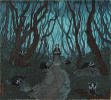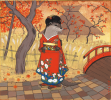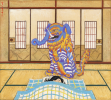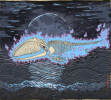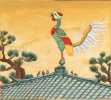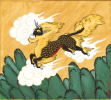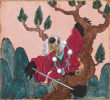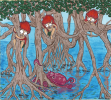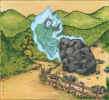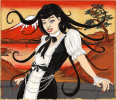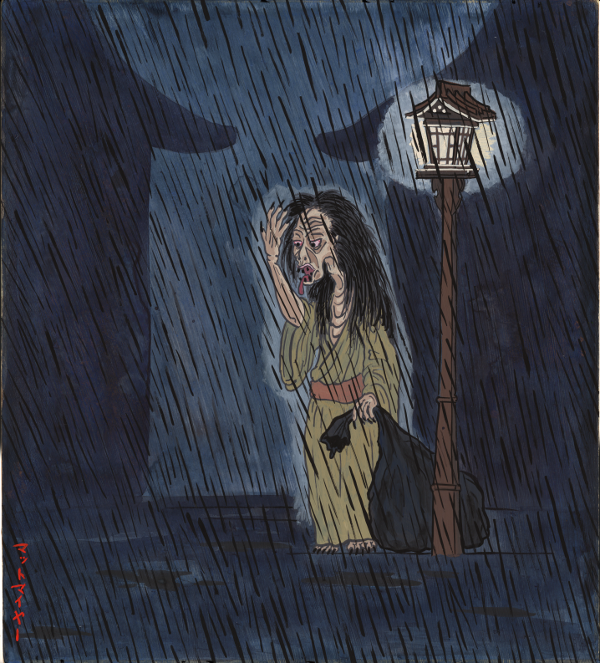We’ve made it! The final A-Yokai-A-Day painting for October 2010! For Halloween I wanted to present something special. Today I bring you the story of Japan’s scariest and most famous ghost of all time! Tokaido Yotsuya Kaidan, the Japanese name of this story, is by far the most popular, most well known, and most terrifying of Japan’s ghost stories. It is a tale of love, betrayal, murder, and revenge. Despite its age, Yotsuya Kaidan makes even today’s ghost stories seem a timid. The ghost story was created by combining and adding some fiction to two contemporary real-life murder stories and adapting them into a single kabuki show. (The first involved two servants who had murdered their respective masters; they were caught and executed on the same day. The second murder was from a samurai who discovered his concubine was having an affair with a servant; the samurai had the faithless concubine and servant nailed to a wooden board and thrown into the Kanda River.) The show became an instant success and went down in history as Japan’s most popular play ever. Since then it has been reproduced into every form of media imaginable, including over 30 movies. Not only that, the influence of the story on Japan’s culture was so strong that every Japanese ghost story since has borrowed from the powerful imagery and mythology in this story, and you can see its direct influence in today’s well-known ghost stories like Ju-On/The Grudge and Ringu/The Ring and their many spin-offs. Even Chinese, American, and other countries’ ghost stories are now taking their imagery from Yotsuya Kaidan (indirectly via the Japanese hit movies which were inspired by it).
Oiwa (The Ghost Story of Yotsuya)
A long time ago in the area of Tokyo known as Yotsuya there was a masterless ronin samurai named Iyemon. He wished to marry a beautiful woman named Oiwa, but her father, Samon, had heard of Iyemon’s past misdeeds and refused to allow him to marry his daughter. Iyemon’s servant Naosuke also wished to marry Oiwa’s sister Osode, who was unfortunately already married to a man named Yomoshichi. So Iyemon and Naosuke conspired to murder Oiwa’s father and his servants, and Osode’s husband. In order to win Oiwa’s and Osode’s marriages, they claimed that a local bandit had done the killings and promised that they would avenge their deaths. The women agree to marry them.
Time passes, and Oiwa bears Iyemon a son. But she grows sickly and weak after giving birth and never completely recovers. Iyemon is forced into lower work in order to support his family, and he grows to strongly resent his invalid wife. Soon, Iyemon falls in love with another woman, Oume, who is the granddaughter of a rich doctor. Iyemon schemes to murder his wife with Oume, and Oume recieves some poison from her grandfather, and gives it to Iyemon who in turn delivers it to Oiwa, telling her that it will make her stronger. Oiwa takes the medicine and grows weaker and weaker, but it does not kill her. Rather, it disfigures her face, causing her eye to sag her skin to scar over and bleed, and her hair to fall out in bloody clumps.
Meanwhile, Naosuke and Osode are married, but despite his numerous advances, she keeps refusing his attempts to consummate the marriage.
Iyemon, grown disgusted by Oiwa’s mangled face, then bribes a local man named Takuetsu to rape Oiwa so that Iyemon will have grounds to divorce her. Takuetsu attempts to do so, but is unable due to the way she looks. Instead, he shows Oiwa her own reflection in a mirror, and Oiwa grows furious. She rushes to kill Takuetsu with a sword, and he tries to block her. Oiwa trips and cuts her own throat open with the sword. Bleeding to death, she kills her infant son so that he will not be raised by Iyemon, and she curses her husband’s name with her dying breath. One of Iyemon’s servants, Kohei, becomes aware of the murder. To silence Kohei, Iyemon murders him, and nails the bodies of Oiwa and Kohei to a board, and drops them into a river. He claims the two were having an affair, and he is released from his marriage.
Iyemon and Oume arrange to be married. On their wedding night, Iyemon sees a vision of Oiwa’s ghost. He slashes at her, cutting off her head, but then the vision clears and he realizes he has just murdered his new wife Oume. Terrified, he rushes to his new father-in-law’s house, where he sees a vision of Kohei. He attacks his ghost as well, and ends up murdering his father-in-law too.
Iyemon then works to purge his now-dead second wife’s family, throwing his mother-in-law into a canal, and drowning their servants. His friend Naosuke continues to pressure Osode to consummate the marriage, but she oddly continues to refuse. Around that time, Yomoshichi returns, having not actually been killed, and accuses Osode of adultery. She is shamed, and resigns to an honorable redemption in death. She begs her two husbands to kill her, and they gladly oblige. Her final act, though, is to leave a note to her husband Naosuke informing him that she was actually his own younger sister. Shamed, Naosuke commits suicide as well — but not before Yomoshichi acquires damning evidence against Iyemon from him.
Meanwhile, Iyemon flees, constantly pursued by the ghosts of the people he has killed. Oiwa’s ruined face follows him everywhere, even appearing (famously) in a paper lantern. He flees to the mountains, but when he goes fishing, instead of fish, he pulls out the board with Oiwa’s and Kohei’s bodies nailed to it. He flees to a cabin, where the vines from the trees and the smoke from the fire transform into Oiwa’s hair and try to ensnare him.
Finally, Iyemon flees his cabin, having lost his mind and descended into madness as his nightmares become his reality. He runs into Yomoshichi, who slays Iyemon out of both pity and vengeance.
Her story doesn’t end there, though. She continues to haunt even today. From my post on onryo last year you may remember that Japanese ghosts, unlike Western ghosts, don’t go away after they are put to rest. There is generally no end to their haunting. And Oiwa, being the most horrible ghost in Japan is certainly no exception.
Oiwa’s body is buried at a temple (Myogo-ji) in Sugamo, Tokyo, and the date of her death is listed as February 22, 1636. There have been numerous reports of accidents, injuries, and even deaths surrounding productions of the play Tokaido Yotsuya Kaidan, and even during TV and movie productions of the story. As a result, there is said to be a famous curse that touches anything and everything related to this story (like the MacBeth curse, only worse). Nowadays, it is customary before starting any movie or TV show that even talks about Oiwa’s story for the principal actors and the director to make a pilgrimage to Oiwa’s grave and ask her permission to perform and for her blessing for their production. Imagine if you were supposed to play the role of Oiwa!! (Incidentally, I did not go to Tokyo prior to writing this, so if anything happens to me in the coming days…)

Oiwa
There you have it, the number one ghost story in Japan! I hope it makes your Halloween a special one!
Okiku is the final yokai in this year’s A-Yokai-A-Day series. But that doesn’t mean I am done painting yokai! I will continue to paint and post yokai throughout this next year. I am now working on an illustrated book of yokai which will include a number of yokai from my A-Yokai-A-Day projects, as well as additional ones I have not yet posted. So stay tuned for more information on that! Remember, you can subscribe to my site via RSS feed, Facebook, Google Friend Connect, or by following @matthewmeyerart on Twitter to stay on top of all of my artwork and blog posts.
Finally, starting tomorrow, the remaining yokai from this series will become available on my Etsy store. You can help support the project as well as own a very special piece of Japan in your own home by visiting osarusan.etsy.com.
Have a Happy Halloween, and thanks so much for clicking back here every day this month!

